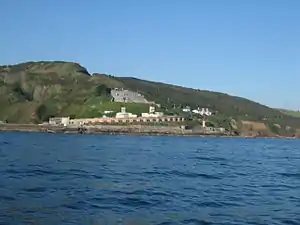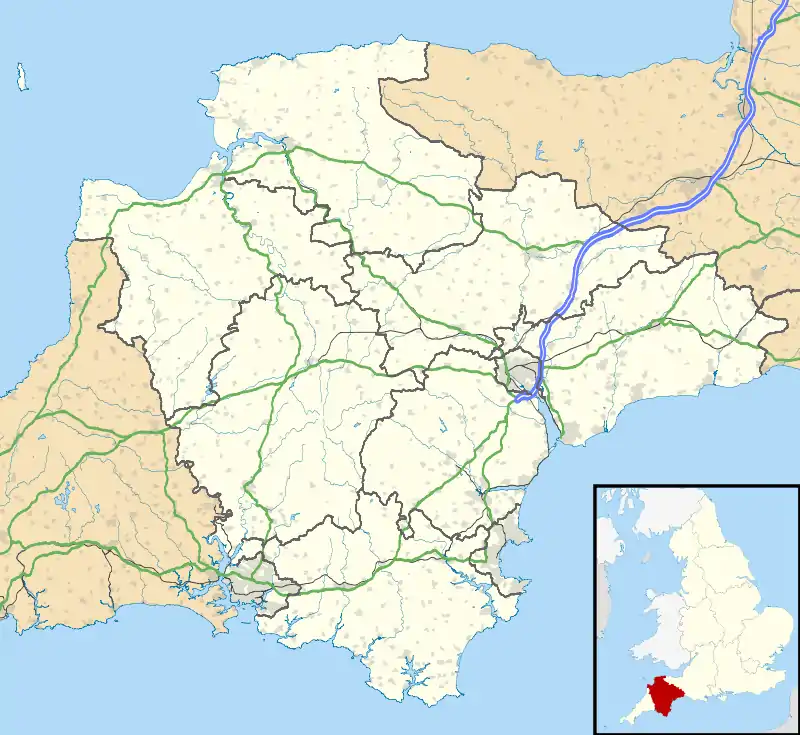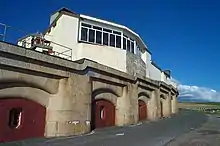Fort Bovisand
Fort Bovisand is a fort in Devon, England near the beach of Bovisand. It was built as a result of the Royal Commission on the Defence of the United Kingdom, which reported in 1860. It is located on the mainland to defend the entrance of Plymouth Sound, at the narrows opposite the east end of Plymouth Breakwater. The fort is beside Bovisand harbour.
| Fort Bovisand | |
|---|---|
 Fort Bovisand from Plymouth Sound | |
 Fort Bovisand | |
| Coordinates | |
| Site information | |
| Open to the public | No |
| Condition | Complete |
| Site history | |
| Built | 1861-1869 |
| Materials | Concrete Masonry |
History

- 1816: A stone jetty and slip were built for boats from sailing warships anchored in Plymouth Sound to collect fresh water from the nearby reservoir.
- 1845: The first fort at the site, named Staddon Height Battery, was started, and still exists in the upper part of the present fort.[1]
Work started on the main part of the fort in 1861. Originally intended to have two stories of casemates like Fort Picklecombe, the design was altered during construction to a single storey of 23 granite casemates with armoured shields. It was designed by Major (later Maj Gen) Whitworth Porter ,[2] and was built by George Baker and Company. The casemates were arranged in an arc and initially housed 22 9-inch Rifled Muzzle Loaders (RMLs) and one 10-inch RML gun, with accommodation for 180 men. Underground there are large deep tunnels to store artillery ammunition safe from enemy gunfire. It was completed in 1869.[3] By 1880 the armament included 14 10-inch and nine 9-inch RML guns. By 1893 it mounted 14 10 inch Rifled Muzzle Loading Guns, eight 9-inch Rifled Muzzle Loading (RML) guns and six 6 Pounder Quick Firing (QF) guns.[4] In 1898 Six 12-pounder quick-firing guns were installed. By the early 1900s the original armament was obsolete and was removed.
In 1942 the remaining four 12-pounders were replaced by two twin 6-pounders, to combat E-boats.[1] A three-storey observation tower to direct the fire of these was built at the same time. The following year a Bofors 40mm anti-aircraft gun was installed.
On the dissolution of coast artillery in 1956 the Ministry of Defence abandoned the fort. In 1970 a lease was granted and the fort was converted into a national commercial diving school and scuba diving centre.
- About the mid-1970s to at least the early 1990s: The fort at the top of the headland (above the coastal path) was used as a schools outdoor activity centre. The upper fort's magazine and various other buildings were converted to be used as basic bunk houses, kitchen and dining area. The cottage was used as a toilet and shower block and a lounge and staff accommodation.
- 2000: By then the main leaseholder — Fort Bovisand Underwater Centre — had liquidated, but other diving services continued trading. Months of argument continued about the status of the leases and viability of existing businesses based there.
- December 2000: Marine Contractors Ltd. (one of the main businesses based there, and one of the parties negotiating to take over the running of Fort Bovisand) went into receivership. As a result, the owners (the Ministry of Defence) decided it was no longer possible to keep the site functioning, and the remaining diving and other firms trading there ceased operations.
- 2003: Discovery Divers was set up.
- Mid-2005: After these businesses failed, the site was bought at auction by PowderCreek Ltd (now known as Fort Bovisand Developments Ltd), and company wholly owned by Greg Dyke, ex-Director General of the BBC, with the aim of saving the site and bringing it back to life.
- Mid 2008: Fort Bovisand was home to Discovery Divers.[5]
- 2011: After examining a number of options, the Fort Bovisand Trust was formed (a registered charitable body) to take forward proposals for a heritage attraction and a bid to the Heritage Lottery Fund. Proposal were for a mixed scheme of the heritage centre, diving business, and some residential units.
- 2013: The Fort Bovisand Trust gained award of a development grant from the Heritage Lottery Fund to progress plans for a heritage visitor attraction and learning centre.
References
- Historic England. "Monument No. 437584". PastScape. Retrieved 7 October 2015.
- Freddy Woodward, (1996) The Historic Defences of Plymouth, Cornwall County Council, p169
- "Fort Bovisand" (PDF). www.victorianforts.co.uk. Victorian Forts and Artillery. Retrieved 2 May 2016.
- The National Archives WO196/31, Ports and harbours Western District: Revision of Coast defence armaments prior to June 1894
- "Welcome to Discovery Divers". Retrieved 2009-09-06.
Bibliography
- Hogg, Ian V (1974). Coast Defences of England and Wales 1856-1956. David & Charles. ISBN 0-7153 6353-0.
- McDonald, Kendall (1997). Fort Bovisand: Divers complete guide. Wreckwalker books. ISBN 0-9528637-1-5.
- Woodward, Freddy (1996). The Historic Defences of Plymouth. Cornwall County Council. ISBN 978-1898166467.